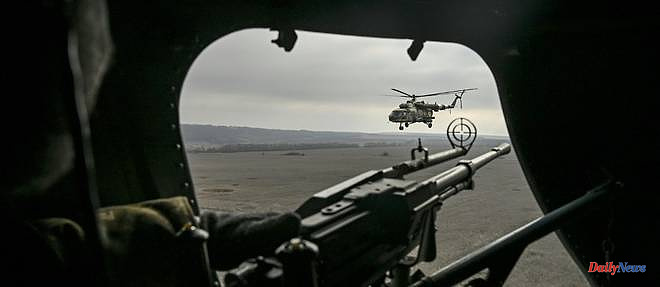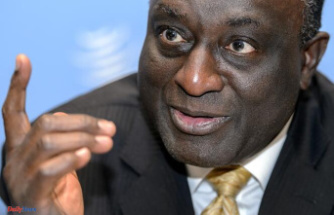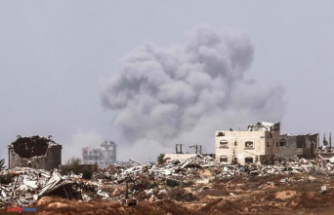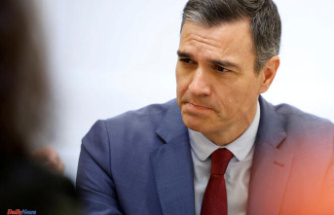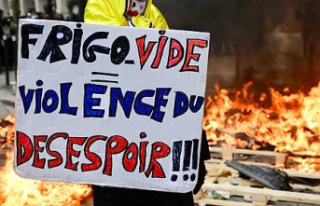Three MI-8 attack helicopters take off from a secret base in Ukraine and fly low to their target near Bakhmout (east), where the battle has been raging for months against Russian forces.
Approaching the objective, one by one, the aircraft suddenly rear up, fire a shower of rockets, take a sharp turn and then return to their starting base, still at very low altitude.
The target was "on a line of enemy fortifications, made up of ground troops, armored vehicles and an ammunition warehouse", Petro, one of the pilots, told AFP after his mission to a duration of approximately 30 minutes.
The target was near Severodonestsk, a locality taken by the Moscow army last spring, located northeast of the city of Bakhmout, where Kiev troops are resisting but are almost surrounded.
Since the Russian invasion a little over a year ago, Ukrainian helicopter pilots have carried out perilous combat missions every day in their old MI-8 and MI-24 aircraft.
In his somewhat baggy pilot's jacket, Petro does not look like much, but at only 23 years old, he already has around fifty combat missions to his credit.
Time to refuel with rockets and kerosene, the young man details the course of the morning attack, part of a place that cannot be revealed for security reasons.
"Before the flight, we choose the route, we use special apps to go through the lowest possible points. For example, if we see heights of 180 m, it's too high, so we look for places down, and we find 130 m, 100 m...", specifies the pilot.
"The goal is to fly lower than the level of the main landscape so as not to be visible to Russian radars, so that they do not know that we are coming, until the very last moment", he continues, under a hood open at eye level.
On impressive images filmed by an AFP camera placed in the cockpit throughout the mission, the landscapes parade at a speed of about 200 km / h and only a few meters below the cabin.
The device suddenly rises for a short time only when firing is triggered on the target, programmed at a distance of 6,100 m.
"When we are 6,200 m from the target, we pitch up 20 degrees (...) Then we launch the rockets, 15 on each side," he explains.
Long ammunition is placed in baskets attached to the right and left edges of the helicopter.
On the images, at the time of the launch, the rockets fuse in front of the MI-8 leaving in their wake plumes of black smoke.
Immediately afterwards, the helicopter made a nearly nose-down turn to the left and then resumed its return flight at low level.
The helicopters - with a pilot and a co-pilot - fire one after the other.
The return route is different from the outward route, "so as not to fall into a trap" and be targeted by Russian anti-aircraft defense fire, Petro said.
On the front line, infantry units, informed in advance of the time of the attack, launch a drone to check if the target has been hit. If it is not, corrections are made for a new shot soon after.
"At the beginning of the war, we didn't have drones. The missions were more complicated and less efficient. But in the summer, we started to receive drones and other equipment. Today, we are more efficient" , according to the pilot.
Firing rockets, without a modern guidance or aiming system, only has an accuracy of about 100 to 200 yards.
His toughest mission took place on March 6, 2022, in the Mykolaiv region (south).
"We were four helicopters and the target was a long convoy of military vehicles", which were heading towards the Zaporijjia nuclear power plant, now occupied by the Russians.
"We saw the target at a distance of about 2 km. We had the information that it was not moving, but in fact it was moving, and we saw it suddenly", and they were targeted by shooting, he recalls.
"Two of our helicopters were destroyed, the third was damaged and I was lucky to be in the fourth. I was not hit (...) Only two of us made it back to the base", he says, still strongly marked by this mission.
Since the beginning of the conflict, about thirty Ukrainian pilots have been killed, according to a military source.
For Petro, "the most difficult thing is the preparation, the decision making on how to act during the flight, in which direction to go towards the target, because you don't know the landscape before the flight, you can't be sure of nothing,” he explains.
"Once we start the engine, the fear disappears, because we have been trained for that, we have confidence in ourselves, in our decisions. So we start the flight without fear", continues the pilot.
If he "dreams" of one day piloting an American Black Hawk attack helicopter, he does not deny the MI-8: "It is not perfect, but it is good, we know it well".
On social networks, videos of Ukrainian helicopters on mission are very shared, and the pilots are seen as heroes.
But Petro thinks above all of the soldiers who “suffer much more than us, even if they greet us and encourage us from the ground”.
"They are in position all the time. Even if we take high risks, it takes us little time to complete a mission. When I see the guys on the ground cheering us on, I know exactly why I'm here," he said.
03/11/2023 16:19:26 - On a helicopter base (Ukraine) (AFP) - © 2023 AFP

